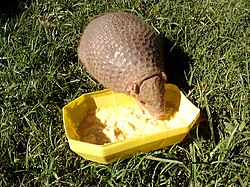| Cabassous | |
|---|---|
 | |
| Chacoan naked-tailed armadillo | |
| Scientific classification | |
| Kingdom: | Animalia |
| Phylum: | Chordata |
| Class: | Mammalia |
| Order: | Cingulata |
| Family: | Chlamyphoridae |
| Subfamily: | Tolypeutinae |
| Genus: | Cabassous McMurtrie, 1831 |
| Type species | |
| Dasypus unicinctus | |
| Species | |
 | |
Cabassous is a genus of South and Central American armadillos. [1] The name is the Latinised form of the Kalini word for "armadillo". [2]
Cladogram of living Cabassous [3]
| Cabassous | |
The genus contains the following four species: [4]
| Image | Scientific name | Common name | Distribution |
|---|---|---|---|
| C. centralis | Northern naked-tailed armadillo | from Chiapas in southern Mexico to western Colombia, northwestern Ecuador and northwestern Venezuela | |
 | C. chacoensis | Chacoan naked-tailed armadillo | the Gran Chaco region of western Paraguay and north-central Argentina |
 | C. tatouay | Greater naked-tailed armadillo | southern Brazil, eastern Paraguay and Uruguay and extreme north-eastern Argentina |
 | C. unicinctus | Southern naked-tailed armadillo | northern South America east of the Andes, as far south as northern Paraguay and southern Brazil. |


